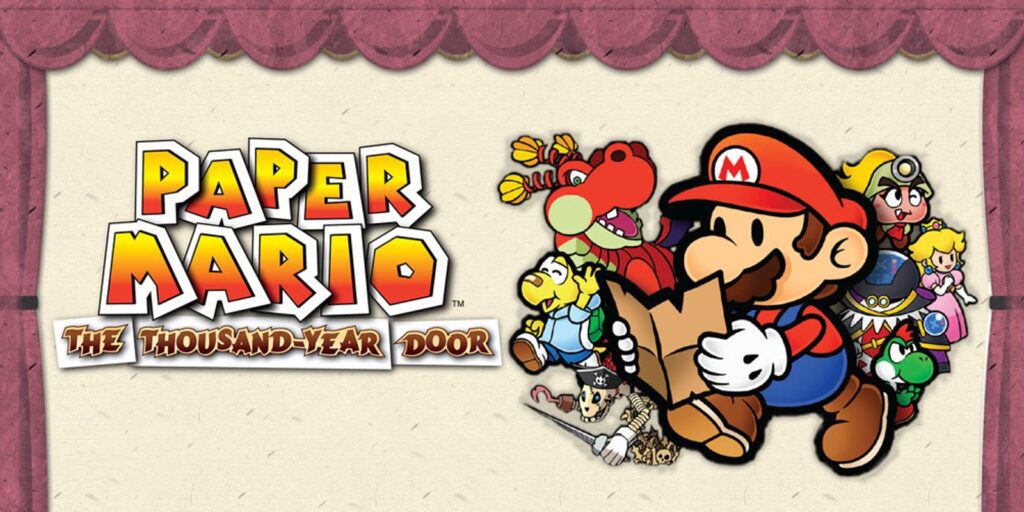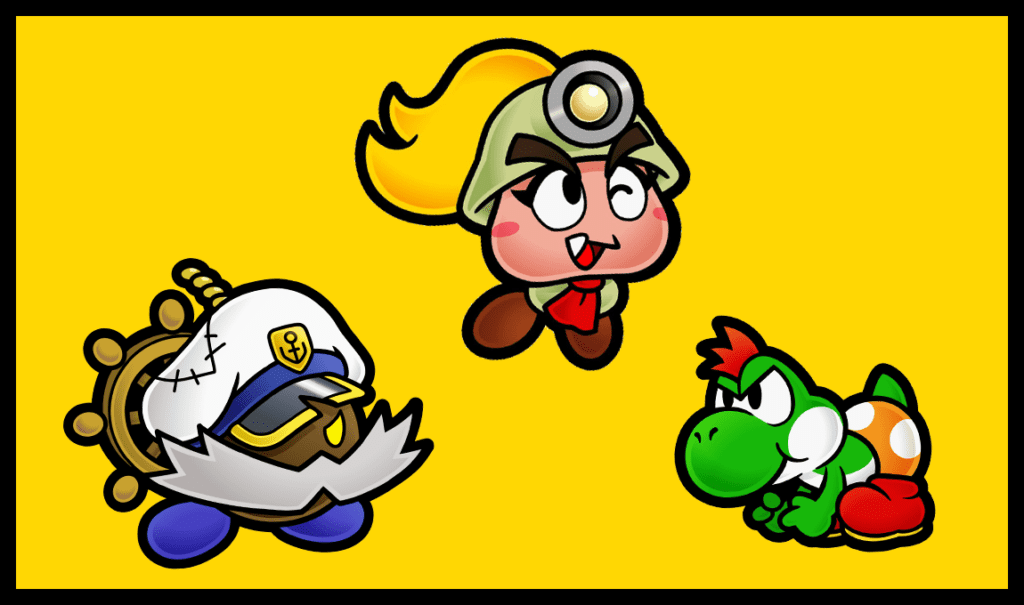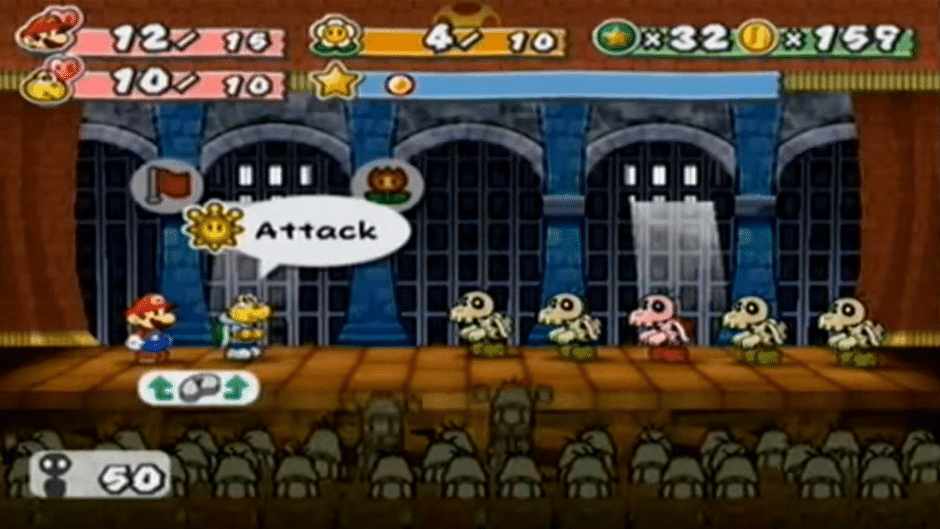
I had to spend 70 bucks to get this game. Not with the case and manual, just the disc. This high price for a 17 year old game is not because it’s rare (it sold decently well) but rather because it’s such a gem on the Gamecube. No other Mario game is like it, and I can tell you that even though it was more expensive than the console I played it on (my backwards-compatible Wii) it was still worth it, because holy cow, this is a really, really good game.
I played my first Paper Mario game last year when Paper Mario: The Origami King (OGK for short) was released for Nintendo Switch, and as you can see in my review, while I thought it was a decent game overall and worth the price, I could see how it was lacking without even having played the originals. And now that I have played through both the original and it’s sequel I can say that… yea, I was right. I liked Origami King, and maybe could even say I enjoyed it more than the first Paper Mario — but in my opinion Thousand Year Door (TTYD for short) was the peak of the series hands down.
To start off with some of the more obvious aspects in which it excels, there’s the locations and story. It’s easily one of, if not the darkest plot a Mario game has ever entertained. You begin your adventure at Rogueport, a seedy town divided by a turf war between a mafia and gang. This already makes it more interesting than any locals in OGK alone but it goes even deeper — underground you could say. See, there was once a prosperous town that thrived a thousand years ago but an evil force (later called a demon) brought chaos and destruction, flooding the land and sinking the ancient town deep below the surface, where it remains to this day. You are actually given access almost immediately to this forgotten city (referred to as Rogueport’s sewers in-game), granted, some areas are only accessible later in your adventure. By the end, however, you will have access to secret shops and challenges, pipes that can take you to almost any location in the entire game, and most importantly, you can walk right up to The Thousand Year Door.
It’s as cool as it sounds, a door that has not been opened for a thousand years, and which Mario must collect all seven crystal stars if he wishes to enter. Luckily, he has been given a magical map from the since-kidnapped Princess Peach that was only able to be obtained by the pure of heart, which suggests that aside from Peach and Mario, there may have been no one else anywhere in Rogueport that was worthy of such power. It’s neat to think about, and all of this backstory helps make the entire experience far more interesting than any other entry has been. It also turns Mario and Peach into way cooler characters than they are usually allowed to be. Listen, I’ve played quite a good few Mario games and in no others have I felt like such a hero. You do begin the journey simply in search of Treasure and the missing Princess, but by the end the stakes are raised to a level so high that only one other Mario game ever (arguably) surpassed it’s story in scope, that being it’s sequel, Super Paper Mario (SPM). As to whether that means TTYD doesn’t have the best story in the series, I will have to wait to decide until I play through SPM, which I am planning to do soon. Now, even with all I just said, the lore still goes deeper but I will cut it short here in an effort to keep some kind of brevity and avoid more spoilers.
Let’s get into the gameplay then. First of all, it’s incredibly deep and very well expanded upon from the original Paper Mario. There’s a LOT of factors at play here. Look at this list.

Goombella, The Yoshi Kid and Admiral Bobbery are just a handful of the many
awesome partners that accompany you along the journey.
– Your partners attack alongside you, have their own levels of HP, along with their own special moves. You can swap them during battle.
– In the usual Mario RPG fashion, you select your attack and target, while the level of damage is based upon how well you perform action commands.
– You have an FP (Flower power) gauge that lets you perform more powerful, character-specific moves.
– You have a SP (Star power) gauge that when proportionately filled enables the strongest, game-changing moves to be made.
– You have BP (Badge points) which you use to equip badges that let you perform even more special attacks along with adjusting your own stats, opening up seemingly endless strategies and builds.
– You can now perform “stylish” commands, which increase your star power when you land them. These are done in between action commands, and so are essentially more action commands, except they do not punish you if you miss them. While it’s not the hugest new addition, it makes battling even more epic.
– There is a roulette wheel that randomly comes up during battle, and if you spin for a third match in the row you get various bonuses. Just try to avoid those poisonous mushrooms…
There are several more factors than these that you have to deal with in battle, but I’ll stop it there. I must admit, at times it does feel like a bit too many things are at play here and I think holding back one of the random elements would have helped even things out. Either way, battling is obviously still a ton of fun.

In short, while the game does have its flaws (such as a lot of boring backtracking) Paper Mario: The Thousand Year Door is still probably the best RPG I have ever played, and is in desperate need of a remaster. You know what else is in desperate need of a remaster?
Your soul! Great segway, isn’t it? Let’s take a moment to reflect on what this game means from the faith perspective, Jimmy Akin style.
While Mario admittedly doesn’t always carry out morally sound tasks in this game (I recall having the choice to beat up a guy or pay him money) the overall theme is a good one. You are helping fix up a poor town you have never seen before, and of course putting yourself in danger in order to save the lives of others. It is very easy to forget about all the places in the world overrun with crime and poverty while we sit in our big houses in the richest countries in the world and complain that old Paper Mario games are expensive.
I recently had the pleasure to listen to a speech by Fr. Tom Hagan, the founder of Hands Together, a charity organization that helps the residents of Haiti’s worst slum. He spared few details and told us how the people he served were regularly eaten by rats, infested with parasites and starved to death. He has even experienced guns being pointed at him during mass and many of those he knows and loves are shot by the same people. That night after the speech I went home to my clean house with an unlimited supply of entertainment and nourishment while Fr. Tom prepared to return to Haiti just after it had been hit by an earthquake. I of course encourage you to donate since just $10 can feed a child for almost a month. Even if you are unable to make a donation I still ask that you pray for them.
Not to end on a sad note,
If Mario can help the poor, we can too! Let’s make both Rogueport and the real world a better place. I love you readers and thank you for sticking around to the end. Here’s our rating summary:
Gameplay: 95%
Story: 5/5
Gameplay: 5/5
Graphics: 5/5
Replayability: 4/5
Morality/Parental Warnings:
Note: These cover the original 2004 English release. Other releases, including the 2024 Switch version, may have some different content.
Language: None
Sex/Nudity: There is a part of the game were one of the characters takes off her clothes but is invisible. Another character randomly kisses Mario for no apparent reason at intervals, and the ghosts by the Pianta mafia casino very vaguely resemble “sexy” workers (think Hooters). Some vague sexual jokes are present.
Violence: Cartoon violence, Mario and co. attack with hammers and the like. You work with pretty nice mafias and gangs. Tragic deaths are mentioned. Some enemies use real weapons such as spears and swords, plus some of the bosses do… eat the audience occasionally. Sheesh Hooktail, they were innocent.
Occult: Some of the help Mario receives is from fortune tellers, you fight an unrealistic demon; two of the main characters are possessed at different points, a few characters receive curses.
